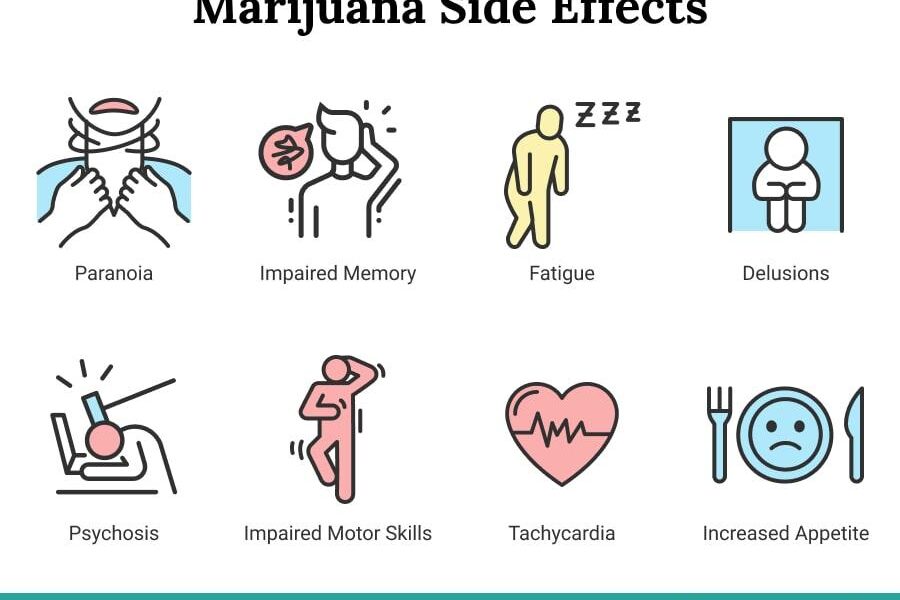As the green wave of cannabis legalization sweeps across states and countries, many are heralding this versatile plant as a remedy for various ailments, ranging from chronic pain to anxiety. However, as individuals turn to cannabis for relief and recreation, it’s crucial to shine a light on the flip side of this natural phenomenon: its side effects. While cannabis can offer numerous benefits, it may also come with a host of unexpected consequences that can impact physical and mental health. In this exploration, we delve into both the well-documented and the lesser-known side effects of cannabis use, aiming to provide a balanced perspective for those seeking to make informed choices about their experience with this ancient herb. Join us as we navigate the complexities of cannabis, detailing the nuances that accompany its usage in today’s ever-evolving landscape.
Table of Contents
- Understanding the Spectrum of Cannabis Side Effects
- Navigating Mental Health Implications for Cannabis Users
- Physical Reactions and Considerations for Safe Usage
- Recommendations for Managing Adverse Effects Effectively
- Q&A
- Wrapping Up
Understanding the Spectrum of Cannabis Side Effects
The consumption of cannabis can lead to a variety of side effects, which can manifest differently depending on the individual. Understanding these effects is crucial, particularly for those considering its use for medicinal or recreational purposes. Common side effects experienced may include:
- Dry mouth: Often referred to as “cottonmouth,” this can be uncomfortable and may require increased hydration.
- Increased appetite: Known colloquially as “the munchies,” many users report a heightened desire for food.
- Paranoia or anxiety: While some find relaxation, others may experience heightened anxiety or paranoia, particularly at higher doses.
- Impaired coordination: Cannabis can affect motor skills and reaction times, which is particularly important to consider when driving or operating machinery.
It’s worth noting that side effects can vary based on the strain and method of consumption. For instance, different cannabinoids and terpenes can influence the overall experience. Here’s a simple table illustrating a few common strains and their associated effects:
| Strain | Primary Effects | Common Side Effects |
|---|---|---|
| Indica | Relaxation, Sedation | Dry mouth, Dizziness |
| Sativa | Euphoria, Energy | Anxiety, Paranoia |
| Hybrid | Balanced effects | Fatigue, Dry eyes |
Navigating Mental Health Implications for Cannabis Users
The intersection of cannabis use and mental health is a complex landscape that warrants careful exploration. While some users turn to cannabis for its anxiety-reducing properties, it’s essential to recognize that the effects can vary significantly. Surprisingly, what may provide solace for one may induce feelings of paranoia or anxiety in another. Factors such as individual biochemistry, dosage, and specific strains play pivotal roles in shaping these experiences. Understanding these nuances helps create a more informed user base that can make choices aligned with their unique mental health needs.
To better grasp the potential mental health implications of cannabis use, consider the following points:
- Short-Term Effects: Users may experience heightened mood, relaxation, or, conversely, anxiety and panic attacks.
- Long-Term Use: Continual exposure could lead to changes in mood disorders or cognitive function.
- Strain Variability: Indica strains might promote calmness, whereas sativa strains can provoke increased energy or anxiety.
- Dosage Matters: Higher doses are often linked to increased side effects, particularly in inexperienced users.
To provide further clarity on the mental health aspects of cannabis, the following table summarizes key effects:
| Effect | Possible Mental Health Influence |
|---|---|
| Relaxation | May alleviate anxiety for some users |
| Heightened Creativity | Can enhance mood or provide new perspectives |
| Paranoia | Potential increase in anxiety and fear |
| Cognitive Impairment | May lead to difficulties in focus and memory |
Physical Reactions and Considerations for Safe Usage
Cannabis consumption can elicit a variety of physical reactions, varying significantly from person to person. Common effects include:
- Increased heart rate: Users may experience a temporary spike in heart rate, which can be alarming but often subsides as the effects wear off.
- Dizziness or lightheadedness: Some individuals report feelings of dizziness, particularly if they are new to cannabis or consume high amounts.
- Dry mouth: Known colloquially as “cottonmouth,” this condition can occur, making hydration essential.
- Red eyes: Cannabis can cause blood vessels in the eyes to expand, leading to a distinctive redness.
Understanding these reactions is crucial for safe usage. Consider the following precautions to mitigate physical risks:
- Start low and go slow: New users should begin with lower doses to assess their tolerance and avoid overwhelming effects.
- Stay hydrated: Drinking water can alleviate dry mouth and help maintain comfort during use.
- Avoid mixing: Combining cannabis with alcohol or other substances can amplify negative physical effects.
| Reaction | Recommendation |
|---|---|
| Increased Heart Rate | Sit down and breathe deeply until symptoms subside. |
| Dizziness | Avoid sudden movements and stay hydrated. |
Recommendations for Managing Adverse Effects Effectively
Managing the adverse effects of cannabis requires a strategic approach tailored to individual needs. It’s crucial to start with a low dosage and gradually increase to find the optimal level of relief without unwanted side effects. Regularly monitor your body’s reactions to cannabis, as sensitivity can vary. Here are some tips to enhance your experience:
- Stay Hydrated: Drink plenty of water to counteract dry mouth, a common side effect.
- Snack Smart: Keep light, healthy snacks on hand to manage potential munchies without overindulging.
- Use CBD: Consider incorporating CBD-rich strains or oils, which may help mitigate psychoactive effects.
- Mind Your Setting: Choose a comfortable, safe environment to minimize anxiety or paranoia.
- Seek Guidance: Consult with a healthcare professional or knowledgeable dispensary staff for personalized advice.
Keeping track of your cannabis use alongside any side effects can be beneficial for long-term management. Utilizing a simple journal can aid in recognizing patterns and making informed adjustments. Below is an example of how to record your experience:
| Date | Strain/Type | Dose | Effects | Additional Notes |
|---|---|---|---|---|
| 01/10/2023 | Indica | 5mg | Relaxation, slight drowsiness | Ideal for evening use |
| 01/12/2023 | Sativa | 10mg | Euphoria, increased energy | Great for daytime activities |
Q&A
Q&A: Exploring the Side Effects of Cannabis
Q: What are the common side effects of cannabis use?
A: Common side effects of cannabis can include dry mouth, red eyes, increased appetite, and sluggishness. Some users may also experience anxiety, paranoia, or dizziness, especially with higher THC strains.
Q: Do side effects vary depending on the method of consumption?
A: Yes, the side effects can differ based on how cannabis is consumed. For instance, smoking may lead to respiratory irritation, while edibles can cause delayed onset effects, leading to unintentional overconsumption.
Q: Are the side effects of cannabis the same for everyone?
A: Not at all. Factors such as individual tolerance, metabolism, previous experience with cannabis, and even genetics can influence how someone reacts to cannabis. What one person finds euphoric, another might deem overwhelming.
Q: How does the strain of cannabis affect its side effects?
A: Different strains have varying concentrations of cannabinoids and terpenes, which can impact the experience. Sativa strains might provoke a more energetic high with less sedation, while indica strains are often associated with relaxation and couch-lock.
Q: Is there a way to mitigate the side effects of cannabis?
A: Yes, users can take several steps to reduce side effects. Staying hydrated, starting with low doses, and opting for strains known for a balanced cannabinoid profile can help manage adverse effects. Meditative practices and breathing exercises might also alleviate anxiety.
Q: Can cannabis use lead to long-term side effects?
A: Long-term use may have its own set of potential side effects, such as dependency, cognitive impairments, or mental health issues like depression and anxiety. It’s important to engage in responsible use and consult professionals if concerns arise.
Q: What should someone do if they experience severe side effects?
A: If someone experiences severe side effects, such as intense paranoia or panic, it can be helpful to find a safe and quiet space, breathe deeply, and focus on calming thoughts. In emergencies, consider reaching medical professionals for support.
Q: Are there any specific populations more at risk for adverse effects?
A: Certain populations, including those with a history of mental health issues, younger individuals with developing brains, or those on specific medications, may be at greater risk for adverse effects. This makes it crucial for these individuals to consult a healthcare provider before using cannabis.
Q: What’s the bottom line on cannabis and side effects?
A: Cannabis can offer enjoyable experiences but is not without its potential side effects, which can vary widely among users. Knowledge and awareness play key roles in navigating cannabis safely and responsibly. Always prioritize informed decision-making.
Wrapping Up
As we draw our exploration of cannabis side effects to a close, it becomes evident that this multifaceted plant holds both promise and complexity. While many users seek its therapeutic benefits, it’s crucial to approach cannabis with a well-informed mindset. The journey through its effects—ranging from the euphoric to the cautionary—reminds us of the delicate balance that nature maintains within our bodies. Just as the leaf dances in the breeze, so too do the experiences of individuals using cannabis vary.
In this evolving landscape of legalization and understanding, education remains our strongest ally. By arming ourselves with knowledge about potential side effects, we can navigate the nuances of cannabis use more safely and purposefully. Ultimately, whether for recreation or relief, informed choices pave the way for richer experiences. The conversation about cannabis is ongoing, and as research continues to unfold, may we remain curious, critical, and compassionate, both towards ourselves and others embarking on their own cannabis journeys.



